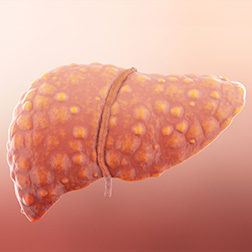Sponsored information from
This is a disease awareness
quiz; it will not be certified for Continuing Medical Education credit.
Think MASH:
Identifying and evaluating suspected cases
Take this short quiz to test your knowledge of metabolic dysfunction‑associated steatohepatitis (MASH).
This quiz aims to test your understanding around when to suspect MASH and how to evaluate suspected cases. A commentary on the correct responses for each question is given. There are ten questions in this quiz. Each question has one correct answer. You will be scored on each question, with a maximum score of 10% per question if answered correctly. Completing this quiz will allow you to download a certificate for your learning records.
Learning objectives
Recognize the risk factors and comorbidities associated with MASH
Stratify the risk of a patient with suspected MASH
Successfully identify and evaluate suspected cases of MASH
References
- Cusi K, Isaacs S, et al. American Association of Clinical Endocrinology clinical practice guideline for the diagnosis and management of nonalcoholic fatty liver disease in primary care and endocrinology clinical settings: co-sponsored by the American Association for the Study of Liver Diseases (AASLD). Endocr Pract. 2022;28(5):528-562.
- Younossi Z M, Golabi P, et al. The global epidemiology of nonalcoholic fatty liver disease (NAFLD) and nonalcoholic steatohepatitis (NASH): a systematic review. Hepatology. 2023;77(4):1335-1347.
- Rinella M E, Lazarus J V, et al. A multisociety Delphi consensus statement on new fatty liver disease nomenclature. J Hepatol. 2023;79(6):1542-1556.
- Chakravarthy M V, Neuschwander-Tetri B A. The metabolic basis of nonalcoholic steatohepatitis. Endocrinol Diabetes Metab. 2020;3(4):e00112.
- Godoy-Matos A F, Silva Junior W S, Valerio C M. NAFLD as a continuum: from obesity to metabolic syndrome and diabetes. Diabetol Metab Syndr. 2020;12:60.
- Jinjuvadia R, Antaki F, et al. The association between nonalcoholic fatty liver disease and metabolic abnormalities in United States population. J Clin Gastroenterol. 2017;51:160–6.
- Rinella M E, Neuschwander-Tetri B A, et al. AASLD practice guidance on the clinical assessment and management of nonalcoholic fatty liver disease. Hepatology. 2023;77(5):1797‑1835.
- Muthiah M D, Cheng Han N, Sanyal A J. A clinical overview of non‑alcoholic fatty liver disease: a guide to diagnosis, the clinical features, and complications‑what the non‑specialist needs to know. Diabetes Obes Metab. 2022;24 Suppl 2:3‑14.
- Tapper E B, Krieger N, et al. The burden of nonalcoholic steatohepatitis (NASH) in the United States. BMC Gastroenterol. 2023;23(1):109.
- Schattenberg J M, Lazarus J V, et al. Disease burden and economic impact of diagnosed non‑alcoholic steatohepatitis in five European countries in 2018: a cost‑of‑illness analysis. Liver Int. 2021;41(6):1227‑1242.
- Kanwal F, Shubrook J H, et al. Clinical care pathway for the risk stratification and management of patients with nonalcoholic fatty liver disease. Gastroenterology. 2021;161(5):1657‑1669.
- Loomba R, Wong R, et al. Nonalcoholic fatty liver disease progression rates to cirrhosis and progression of cirrhosis to decompensation and mortality: a real world analysis of Medicare data. Aliment Pharmacol Ther. 2020;51(11):1149‑1159.
- Ng C H, Lim W H, et al. Mortality outcomes by fibrosis stage in nonalcoholic fatty liver disease: a systematic review and meta‑analysis. Clin Gastroenterol Hepatol. 2023;21(4):931‑939 e935.
- Twiss J, Whalley D, et al. Validation of NASH‑CHECK: a novel patient‑reported outcome measure for nonalcoholic steatohepatitis. J Patient Rep Outcomes. 2023;7(1):69.
- Adams L A, Anstee Q M, et al. Non‑alcoholic fatty liver disease and its relationship with cardiovascular disease and other extrahepatic diseases. Gut. 2017;66(6):1138‑1153.
- Aminian A, Al‑Kurd A, et al. Association of bariatric surgery with major adverse liver and cardiovascular outcomes in patients with biopsy‑proven nonalcoholic steatohepatitis. JAMA. 2021;326(20):2031‑2042.
- Shroff H, VanWagner L B. Cardiovascular disease in nonalcoholic steatohepatitis: screening and management. Curr Hepatol Rep. 2020;19(3):315‑326.
- Quek J, Chan K E, et al. Global prevalence of non‑alcoholic fatty liver disease and non‑alcoholic steatohepatitis in the overweight and obese population: a systematic review and meta‑analysis. Lancet Gastroenterol Hepatol. 2023;8(1):20‑30.
- Younossi Z M, Golabi P, et al. The global epidemiology of NAFLD and NASH in patients with type 2 diabetes: a systematic review and meta‑analysis. J Hepatol. 2019;71(4):793‑801.
- Vilar‑Gomez E, Martinez‑Perez Y, et al. Weight loss through lifestyle modification significantly reduces features of nonalcoholic steatohepatitis. Gastroenterology. 2015;149(2):367‑378.
- Patel K, Sebastiani G. Limitations of non‑invasive tests for assessment of liver fibrosis. JHEP Rep. 2020;2(2):100067.
- Francque S, Vonghia L. Pharmacological treatment for non‑alcoholic fatty liver disease. Adv Ther. 2019;36(5):1052‑1074.
- Ekstedt M, Hagstrom H, et al. Fibrosis stage is the strongest predictor for disease‑specific mortality in NAFLD after up to 33 years of follow‑up. Hepatology. 2015;61(5):1547-1554.














